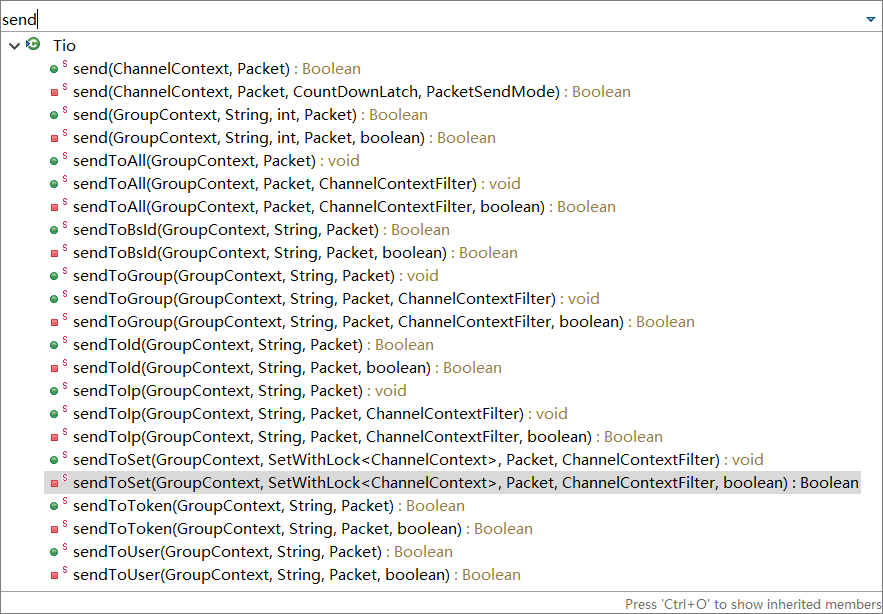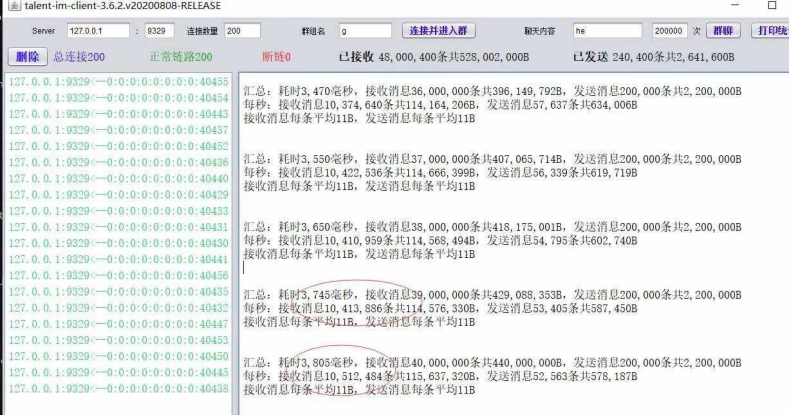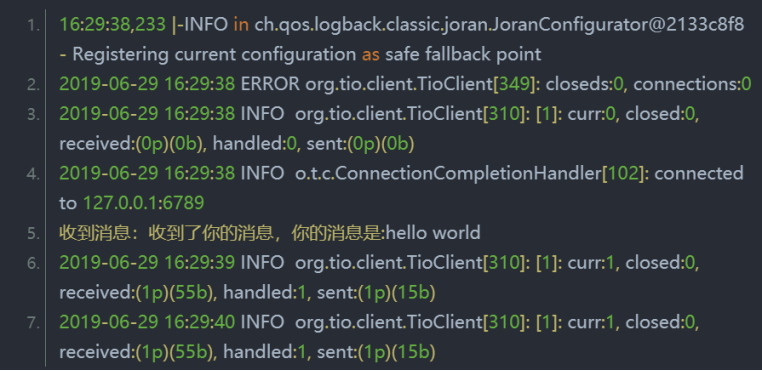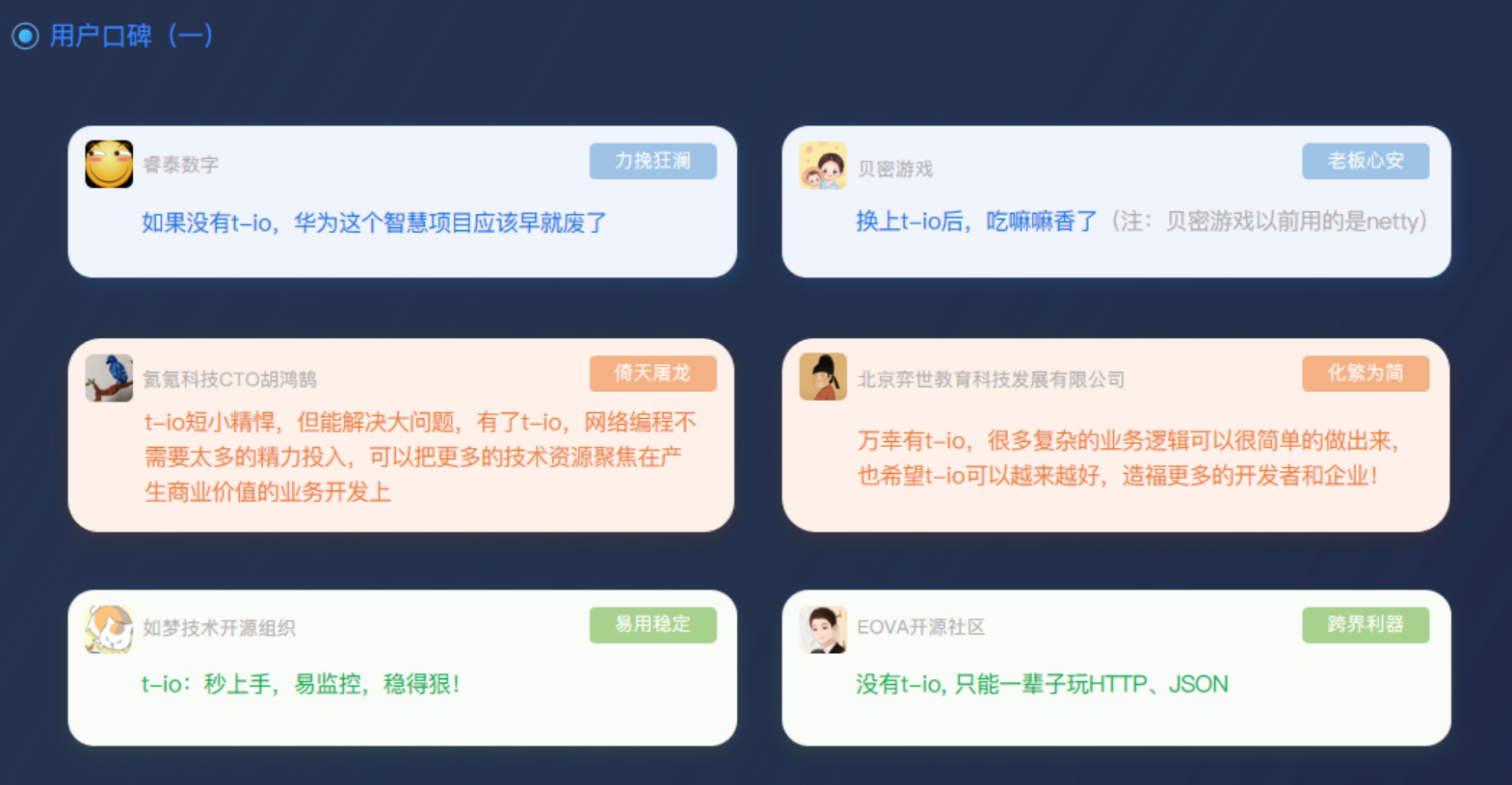t-io作为目前国内最流行的开源网络编程框架软件,以简单易懂,上手容易而著称,相同的功能比起netty实现起来,要简单的多,代码量也大大减少,如果要使用好t-io,还是要先学习t-io的一些基本知识,这篇文章主要从8个方面介绍了t-io的基础知识。 具体请参考: https://www.wanetech.com/doc/tio/88
t-io收发消息过程
t-io收发消息及处理过程,可以用一张图清晰地表达出来
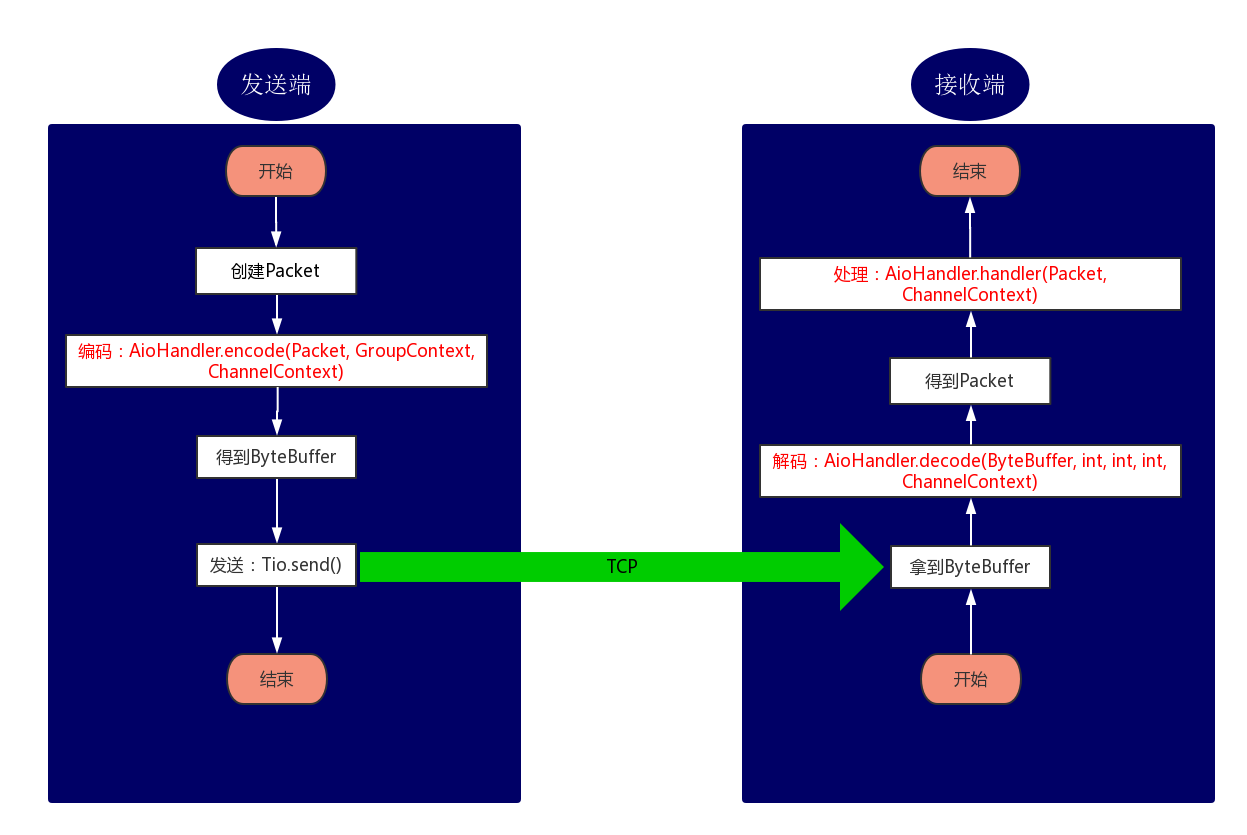
应用层包:Packet
Packet是用于表述业务数据结构的,我们通过继承Packet来实现自己的业务数据结构,对于各位而言,把Packet看作是一个普通的VO对象即可。
注意:不建议直接使用Packet对象,而是要继承Packet
一个简单的Packet可能长这样
package org.tio.study.helloworld.common;
import org.tio.core.intf.Packet;
/**
* @author tanyaowu
*/
public class HelloPacket extends Packet {
private static final long serialVersionUID = -172060606924066412L;
public static final int HEADER_LENGTH = 4;//消息头的长度
public static final String CHARSET = "utf-8";
private byte[] body;
/**
* @return the body
*/
public byte[] getBody() {
return body;
}
/**
* @param body the body to set
*/
public void setBody(byte[] body) {
this.body = body;
}
}可以结合AioHandler.java理解Packet
import java.nio.ByteBuffer;
import org.tio.core.ChannelContext;
import org.tio.core.TioConfig;
import org.tio.core.exception.AioDecodeException;
/**
*
* @author tanyaowu
* 2017年10月19日 上午9:40:15
*/
public interface AioHandler {
/**
* 根据ByteBuffer解码成业务需要的Packet对象.
* 如果收到的数据不全,导致解码失败,请返回null,在下次消息来时框架层会自动续上前面的收到的数据
* @param buffer 参与本次希望解码的ByteBuffer
* @param limit ByteBuffer的limit
* @param position ByteBuffer的position,不一定是0哦
* @param readableLength ByteBuffer参与本次解码的有效数据(= limit - position)
* @param channelContext
* @return
* @throws AioDecodeException
*/
Packet decode(ByteBuffer buffer, int limit, int position, int readableLength, ChannelContext channelContext) throws AioDecodeException;
/**
* 编码
* @param packet
* @param tioConfig
* @param channelContext
* @return
* @author: tanyaowu
*/
ByteBuffer encode(Packet packet, TioConfig tioConfig, ChannelContext channelContext);
/**
* 处理消息包
* @param packet
* @param channelContext
* @throws Exception
* @author: tanyaowu
*/
void handler(Packet packet, ChannelContext channelContext) throws Exception;
}单条TCP连接上下文:ChannelContext
每一个tcp连接的建立都会产生一个ChannelContext对象,这是个抽象类,如果你是用t-io作tcp客户端,那么就是ClientChannelContext,如果你是用tio作tcp服务器,那么就是ServerChannelContext
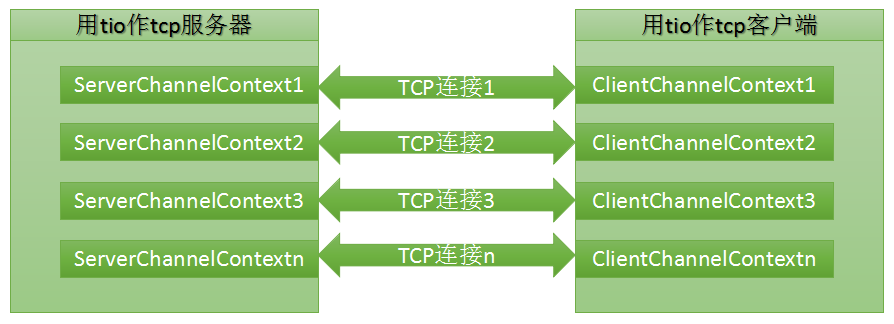 用户可以把业务数据通过ChannelContext对象和TCP连接关联起来,像下面这样设置属性
用户可以把业务数据通过ChannelContext对象和TCP连接关联起来,像下面这样设置属性
ChannelContext.set(String key, Object value)然后用下面的方式获取属性
ChannelContext.get(String key)当然最最常用的还是用t-io提供的强到没对手的bind功能,譬如用下面的代码绑定userid
Tio.bindUser(ChannelContext channelContext, String userid)然后可以通过userid进行操作,示范代码如下
//获取某用户的ChannelContext集合
SetWithLock<ChannelContext> set = Tio.getChannelContextsByUserid(tioConfig, userid);
//给某用户发消息
Tio.sendToUser(TioConfig, userid, Packet)除了可以绑定userid,t-io还内置了如下绑定API
- 无序列表绑定业务id
Tio.bindBsId(ChannelContext channelContext, String bsId) - 绑定token
Tio.bindToken(ChannelContext channelContext, String token) - 绑定群组
ChannelContext对象包含的信息非常多,主要对象见下图Tio.bindGroup(ChannelContext channelContext, String group)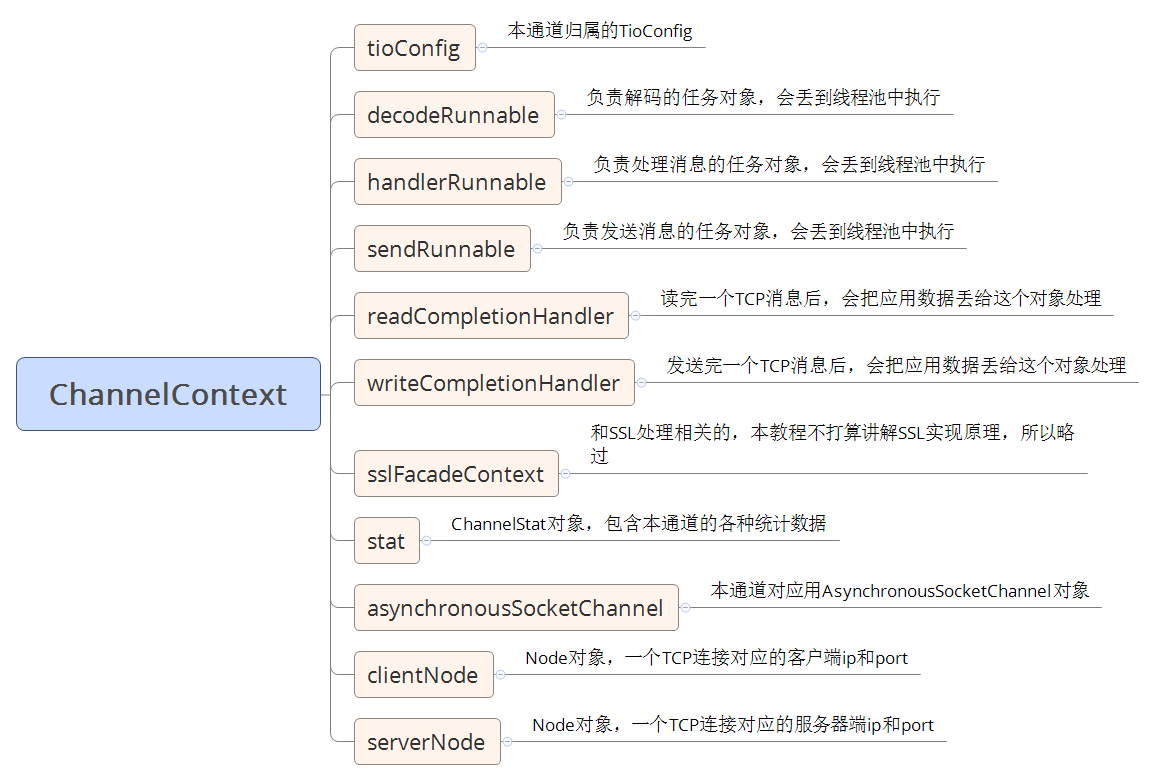
- 说明*
ChannelContext是t-io中非常重要的类,他是业务和连接的沟通桥梁!
服务配置与维护:TioConfig
场景:我们在写TCP Server时,都会先选好一个端口以监听客户端连接,再创建N组线程池来执行相关的任务,譬如发送消息、解码数据包、处理数据包等任务,还要维护客户端连接的各种数据,为了和业务互动,还要把这些客户端连接和各种业务数据绑定起来,譬如把某个客户端绑定到一个群组,绑定到一个userid,绑定到一个token等。 TioConfig就是解决以上场景的:配置线程池、监听端口,维护客户端各种数据等的。
TioConfig是个抽象类
如果你是用tio作tcp客户端,那么你需要创建ClientTioConfig对象
服务器端对应一个ClientTioConfig对象
如果你是用tio作tcp服务器,那么你需要创建ServerTioConfig
一个监听端口对应一个ServerTioConfig ,一个jvm可以监听多个端口,所以一个jvm可以有多个ServerTioConfig对象
TioConfig对象包含的信息非常多,主要对象见下图
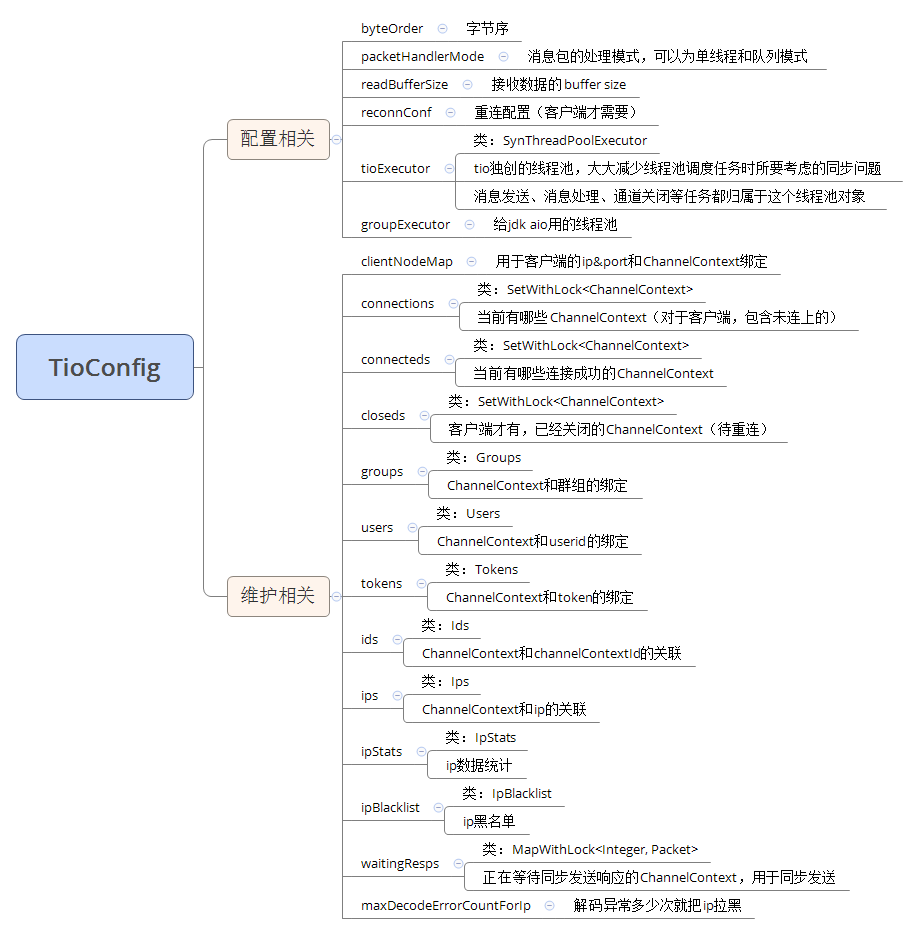 如何获取TioConfig对象
见:https://www.wanetech.com/doc/tio/253?pageNumber=1
如何获取TioConfig对象
见:https://www.wanetech.com/doc/tio/253?pageNumber=1
编码、解码、处理:AioHandler
AioHandler是处理消息的核心接口,它有两个子接口,ClientAioHandler和ServerAioHandler,当用tio作tcp客户端时需要实现ClientAioHandler,当用tio作tcp服务器时需要实现ServerAioHandler,它主要定义了3个方法,见下
import java.nio.ByteBuffer;
import org.tio.core.ChannelContext;
import org.tio.core.TioConfig;
import org.tio.core.exception.AioDecodeException;
/**
*
* @author tanyaowu
* 2017年10月19日 上午9:40:15
*/
public interface AioHandler {
/**
* 根据ByteBuffer解码成业务需要的Packet对象.
* 如果收到的数据不全,导致解码失败,请返回null,在下次消息来时框架层会自动续上前面的收到的数据
* @param buffer 参与本次希望解码的ByteBuffer
* @param limit ByteBuffer的limit
* @param position ByteBuffer的position,不一定是0哦
* @param readableLength ByteBuffer参与本次解码的有效数据(= limit - position)
* @param channelContext
* @return
* @throws AioDecodeException
*/
Packet decode(ByteBuffer buffer, int limit, int position, int readableLength, ChannelContext channelContext) throws AioDecodeException;
/**
* 编码
* @param packet
* @param tioConfig
* @param channelContext
* @return
* @author: tanyaowu
*/
ByteBuffer encode(Packet packet, TioConfig tioConfig, ChannelContext channelContext);
/**
* 处理消息包
* @param packet
* @param channelContext
* @throws Exception
* @author: tanyaowu
*/
void handler(Packet packet, ChannelContext channelContext) throws Exception;
}消息来往监听:AioListener
AioListener是处理消息的核心接口,它有两个子接口:ClientAioListener和ServerAioListener
当用tio作tcp客户端时需要实现ClientAioListener 当用tio作tcp服务器时需要实现ServerAioListener 它主要定义了如下方法
package org.tio.core.intf;
import org.tio.core.ChannelContext;
/**
*
* @author tanyaowu
* 2017年4月1日 上午9:34:08
*/
public interface AioListener {
/**
* 建链后触发本方法,注:建链不一定成功,需要关注参数isConnected
* @param channelContext
* @param isConnected 是否连接成功,true:表示连接成功,false:表示连接失败
* @param isReconnect 是否是重连, true: 表示这是重新连接,false: 表示这是第一次连接
* @throws Exception
* @author: tanyaowu
*/
public void onAfterConnected(ChannelContext channelContext, boolean isConnected, boolean isReconnect) throws Exception;
/**
* 原方法名:onAfterDecoded
* 解码成功后触发本方法
* @param channelContext
* @param packet
* @param packetSize
* @throws Exception
* @author: tanyaowu
*/
public void onAfterDecoded(ChannelContext channelContext, Packet packet, int packetSize) throws Exception;
/**
* 接收到TCP层传过来的数据后
* @param channelContext
* @param receivedBytes 本次接收了多少字节
* @throws Exception
*/
public void onAfterReceivedBytes(ChannelContext channelContext, int receivedBytes) throws Exception;
/**
* 消息包发送之后触发本方法
* @param channelContext
* @param packet
* @param isSentSuccess true:发送成功,false:发送失败
* @throws Exception
* @author tanyaowu
*/
public void onAfterSent(ChannelContext channelContext, Packet packet, boolean isSentSuccess) throws Exception;
/**
* 处理一个消息包后
* @param channelContext
* @param packet
* @param cost 本次处理消息耗时,单位:毫秒
* @throws Exception
*/
public void onAfterHandled(ChannelContext channelContext, Packet packet, long cost) throws Exception;
/**
* 连接关闭前触发本方法
* @param channelContext the channelcontext
* @param throwable the throwable 有可能为空
* @param remark the remark 有可能为空
* @param isRemove
* @author tanyaowu
* @throws Exception
*/
public void onBeforeClose(ChannelContext channelContext, Throwable throwable, String remark, boolean isRemove) throws Exception;
/**
* 连接关闭前后触发本方法
* 警告:走到这个里面时,很多绑定的业务都已经解绑了,所以这个方法一般是空着不实现的
* @param channelContext the channelcontext
* @param throwable the throwable 有可能为空
* @param remark the remark 有可能为空
* @param isRemove 是否是删除
* @throws Exception
* @author: tanyaowu
*/
// public void onAfterClose(ChannelContext channelContext, Throwable throwable, String remark, boolean isRemove) throws Exception;
}服务器端入口:TioServer
这个对象大家稍微了解一下即可,服务器启动时会用到这个对象,简单贴一下它的源代码吧,大家只需要关注它有一个start()方法是用来启动网络服务的即可
import java.io.IOException;
import java.lang.management.ManagementFactory;
import java.lang.management.RuntimeMXBean;
import java.net.InetSocketAddress;
import java.net.StandardSocketOptions;
import java.nio.channels.AsynchronousChannelGroup;
import java.nio.channels.AsynchronousServerSocketChannel;
import java.util.ArrayList;
import java.util.Date;
import java.util.List;
import java.util.concurrent.TimeUnit;
import org.slf4j.Logger;
import org.slf4j.LoggerFactory;
import org.tio.core.Node;
import org.tio.utils.SysConst;
import org.tio.utils.date.DateUtils;
import org.tio.utils.hutool.StrUtil;
/**
* @author tanyaowu
*
*/
public class TioServer {
private static Logger log = LoggerFactory.getLogger(TioServer.class);
private ServerTioConfig serverTioConfig;
private AsynchronousServerSocketChannel serverSocketChannel;
private AsynchronousChannelGroup channelGroup = null;
private Node serverNode;
private boolean isWaitingStop = false;
/**
*
* @param serverTioConfig
*
* @author tanyaowu
* 2017年1月2日 下午5:53:06
*
*/
public TioServer(ServerTioConfig serverTioConfig) {
super();
this.serverTioConfig = serverTioConfig;
}
/**
* @return the serverTioConfig
*/
public ServerTioConfig getServerTioConfig() {
return serverTioConfig;
}
/**
* @return the serverNode
*/
public Node getServerNode() {
return serverNode;
}
/**
* @return the serverSocketChannel
*/
public AsynchronousServerSocketChannel getServerSocketChannel() {
return serverSocketChannel;
}
/**
* @return the isWaitingStop
*/
public boolean isWaitingStop() {
return isWaitingStop;
}
/**
* @param serverTioConfig the serverTioConfig to set
*/
public void setServerTioConfig(ServerTioConfig serverTioConfig) {
this.serverTioConfig = serverTioConfig;
}
/**
* @param isWaitingStop the isWaitingStop to set
*/
public void setWaitingStop(boolean isWaitingStop) {
this.isWaitingStop = isWaitingStop;
}
public void start(String serverIp, int serverPort) throws IOException {
long start = System.currentTimeMillis();
this.serverNode = new Node(serverIp, serverPort);
channelGroup = AsynchronousChannelGroup.withThreadPool(serverTioConfig.groupExecutor);
serverSocketChannel = AsynchronousServerSocketChannel.open(channelGroup);
serverSocketChannel.setOption(StandardSocketOptions.SO_REUSEADDR, true);
serverSocketChannel.setOption(StandardSocketOptions.SO_RCVBUF, 64 * 1024);
InetSocketAddress listenAddress = null;
if (StrUtil.isBlank(serverIp)) {
listenAddress = new InetSocketAddress(serverPort);
} else {
listenAddress = new InetSocketAddress(serverIp, serverPort);
}
serverSocketChannel.bind(listenAddress, 0);
AcceptCompletionHandler acceptCompletionHandler = serverTioConfig.getAcceptCompletionHandler();
serverSocketChannel.accept(this, acceptCompletionHandler);
serverTioConfig.startTime = System.currentTimeMillis();
//下面这段代码有点无聊,写得随意,纯粹是为了打印好看些
String baseStr = "|----------------------------------------------------------------------------------------|";
int baseLen = baseStr.length();
StackTraceElement[] ses = Thread.currentThread().getStackTrace();
StackTraceElement se = ses[ses.length - 1];
int xxLen = 18;
int aaLen = baseLen - 3;
List<String> infoList = new ArrayList<>();
infoList.add(StrUtil.fillAfter("Tio gitee address", ' ', xxLen) + "| " + SysConst.TIO_URL_GITEE);
infoList.add(StrUtil.fillAfter("Tio site address", ' ', xxLen) + "| " + SysConst.TIO_URL_SITE);
infoList.add(StrUtil.fillAfter("Tio version", ' ', xxLen) + "| " + SysConst.TIO_CORE_VERSION);
infoList.add(StrUtil.fillAfter("-", '-', aaLen));
infoList.add(StrUtil.fillAfter("TioConfig name", ' ', xxLen) + "| " + serverTioConfig.getName());
infoList.add(StrUtil.fillAfter("Started at", ' ', xxLen) + "| " + DateUtils.formatDateTime(new Date()));
infoList.add(StrUtil.fillAfter("Listen on", ' ', xxLen) + "| " + this.serverNode);
infoList.add(StrUtil.fillAfter("Main Class", ' ', xxLen) + "| " + se.getClassName());
try {
RuntimeMXBean runtimeMxBean = ManagementFactory.getRuntimeMXBean();
String runtimeName = runtimeMxBean.getName();
String pid = runtimeName.split("@")[0];
long startTime = runtimeMxBean.getStartTime();
long startCost = System.currentTimeMillis() - startTime;
infoList.add(StrUtil.fillAfter("Jvm start time", ' ', xxLen) + "| " + startCost + " ms");
infoList.add(StrUtil.fillAfter("Tio start time", ' ', xxLen) + "| " + (System.currentTimeMillis() - start) + " ms");
infoList.add(StrUtil.fillAfter("Pid", ' ', xxLen) + "| " + pid);
} catch (Exception e) {
}
//100
String printStr = "\r\n"+baseStr+"\r\n";
// printStr += "|--" + leftStr + " " + info + " " + rightStr + "--|\r\n";
for (String string : infoList) {
printStr += "| " + StrUtil.fillAfter(string, ' ', aaLen) + "|\r\n";
}
printStr += baseStr + "\r\n";
if (log.isInfoEnabled()) {
log.info(printStr);
} else {
System.out.println(printStr);
}
}
/**
*
* @return
* @author tanyaowu
*/
public boolean stop() {
isWaitingStop = true;
boolean ret = true;
try {
channelGroup.shutdownNow();
} catch (Exception e) {
log.error("channelGroup.shutdownNow()时报错", e);
}
try {
serverSocketChannel.close();
} catch (Exception e1) {
log.error("serverSocketChannel.close()时报错", e1);
}
try {
serverTioConfig.groupExecutor.shutdown();
} catch (Exception e1) {
log.error(e1.toString(), e1);
}
try {
serverTioConfig.tioExecutor.shutdown();
} catch (Exception e1) {
log.error(e1.toString(), e1);
}
serverTioConfig.setStopped(true);
try {
ret = ret && serverTioConfig.groupExecutor.awaitTermination(6000, TimeUnit.SECONDS);
ret = ret && serverTioConfig.tioExecutor.awaitTermination(6000, TimeUnit.SECONDS);
} catch (InterruptedException e) {
log.error(e.getLocalizedMessage(), e);
}
log.info(this.serverNode + " stopped");
return ret;
}
}客户端入口:TioClient
只有当你在用t-io作为TCP客户端时,才用得到TioClient,此处简单贴一下它的源代码,它的用法,见后面的showcase示范工程
package org.tio.client;
import java.io.IOException;
import java.net.InetSocketAddress;
import java.net.StandardSocketOptions;
import java.nio.channels.AsynchronousChannelGroup;
import java.nio.channels.AsynchronousSocketChannel;
import java.util.Set;
import java.util.concurrent.CountDownLatch;
import java.util.concurrent.LinkedBlockingQueue;
import java.util.concurrent.TimeUnit;
import java.util.concurrent.locks.ReentrantReadWriteLock;
import java.util.concurrent.locks.ReentrantReadWriteLock.ReadLock;
import java.util.concurrent.locks.ReentrantReadWriteLock.WriteLock;
import org.slf4j.Logger;
import org.slf4j.LoggerFactory;
import org.tio.client.intf.ClientAioHandler;
import org.tio.core.ChannelContext;
import org.tio.core.Node;
import org.tio.core.Tio;
import org.tio.core.intf.Packet;
import org.tio.core.ssl.SslFacadeContext;
import org.tio.core.stat.ChannelStat;
import org.tio.utils.SystemTimer;
import org.tio.utils.hutool.StrUtil;
import org.tio.utils.lock.SetWithLock;
/**
*
* @author tanyaowu
* 2017年4月1日 上午9:29:58
*/
public class TioClient {
/**
* 自动重连任务
* @author tanyaowu
*
*/
private static class ReconnRunnable implements Runnable {
ClientChannelContext channelContext = null;
TioClient tioClient = null;
// private static Map<Node, Long> cacheMap = new HashMap<>();
public ReconnRunnable(ClientChannelContext channelContext, TioClient tioClient) {
this.channelContext = channelContext;
this.tioClient = tioClient;
}
/**
* @see java.lang.Runnable#run()
*
* @author tanyaowu
* 2017年2月2日 下午8:24:40
*
*/
@Override
public void run() {
ReentrantReadWriteLock closeLock = channelContext.closeLock;
WriteLock writeLock = closeLock.writeLock();
writeLock.lock();
try {
if (!channelContext.isClosed) //已经连上了,不需要再重连了
{
return;
}
long start = SystemTimer.currTime;
tioClient.reconnect(channelContext, 2);
long end = SystemTimer.currTime;
long iv = end - start;
if (iv >= 100) {
log.error("{},重连耗时:{} ms", channelContext, iv);
} else {
log.info("{},重连耗时:{} ms", channelContext, iv);
}
if (channelContext.isClosed) {
channelContext.setReconnCount(channelContext.getReconnCount() + 1);
// cacheMap.put(channelContext.getServerNode(), SystemTimer.currTime);
return;
}
} catch (java.lang.Throwable e) {
log.error(e.toString(), e);
} finally {
writeLock.unlock();
}
}
}
private static Logger log = LoggerFactory.getLogger(TioClient.class);
private AsynchronousChannelGroup channelGroup;
private ClientTioConfig clientTioConfig;
/**
* @param serverIp 可以为空
* @param serverPort
* @param aioDecoder
* @param aioEncoder
* @param aioHandler
*
* @author tanyaowu
* @throws IOException
*
*/
public TioClient(final ClientTioConfig clientTioConfig) throws IOException {
super();
this.clientTioConfig = clientTioConfig;
this.channelGroup = AsynchronousChannelGroup.withThreadPool(clientTioConfig.groupExecutor);
startHeartbeatTask();
startReconnTask();
}
/**
*
* @param serverNode
* @throws Exception
*
* @author tanyaowu
*
*/
public void asynConnect(Node serverNode) throws Exception {
asynConnect(serverNode, null);
}
/**
*
* @param serverNode
* @param timeout
* @throws Exception
*
* @author tanyaowu
*
*/
public void asynConnect(Node serverNode, Integer timeout) throws Exception {
asynConnect(serverNode, null, null, timeout);
}
/**
*
* @param serverNode
* @param bindIp
* @param bindPort
* @param timeout
* @throws Exception
*
* @author tanyaowu
*
*/
public void asynConnect(Node serverNode, String bindIp, Integer bindPort, Integer timeout) throws Exception {
connect(serverNode, bindIp, bindPort, null, timeout, false);
}
/**
*
* @param serverNode
* @return
* @throws Exception
*
* @author tanyaowu
*
*/
public ClientChannelContext connect(Node serverNode) throws Exception {
return connect(serverNode, null);
}
/**
*
* @param serverNode
* @param timeout
* @return
* @throws Exception
* @author tanyaowu
*/
public ClientChannelContext connect(Node serverNode, Integer timeout) throws Exception {
return connect(serverNode, null, 0, timeout);
}
/**
*
* @param serverNode
* @param bindIp
* @param bindPort
* @param initClientChannelContext
* @param timeout 超时时间,单位秒
* @return
* @throws Exception
* @author tanyaowu
*/
public ClientChannelContext connect(Node serverNode, String bindIp, Integer bindPort, ClientChannelContext initClientChannelContext, Integer timeout) throws Exception {
return connect(serverNode, bindIp, bindPort, initClientChannelContext, timeout, true);
}
/**
*
* @param serverNode
* @param bindIp
* @param bindPort
* @param initClientChannelContext
* @param timeout 超时时间,单位秒
* @param isSyn true: 同步, false: 异步
* @return
* @throws Exception
* @author tanyaowu
*/
private ClientChannelContext connect(Node serverNode, String bindIp, Integer bindPort, ClientChannelContext initClientChannelContext, Integer timeout, boolean isSyn)
throws Exception {
AsynchronousSocketChannel asynchronousSocketChannel = null;
ClientChannelContext channelContext = null;
boolean isReconnect = initClientChannelContext != null;
// ClientAioListener clientAioListener = clientTioConfig.getClientAioListener();
long start = SystemTimer.currTime;
asynchronousSocketChannel = AsynchronousSocketChannel.open(channelGroup);
long end = SystemTimer.currTime;
long iv = end - start;
if (iv >= 100) {
log.error("{}, open 耗时:{} ms", channelContext, iv);
}
asynchronousSocketChannel.setOption(StandardSocketOptions.TCP_NODELAY, true);
asynchronousSocketChannel.setOption(StandardSocketOptions.SO_REUSEADDR, true);
asynchronousSocketChannel.setOption(StandardSocketOptions.SO_KEEPALIVE, true);
InetSocketAddress bind = null;
if (bindPort != null && bindPort > 0) {
if (false == StrUtil.isBlank(bindIp)) {
bind = new InetSocketAddress(bindIp, bindPort);
} else {
bind = new InetSocketAddress(bindPort);
}
}
if (bind != null) {
asynchronousSocketChannel.bind(bind);
}
channelContext = initClientChannelContext;
start = SystemTimer.currTime;
InetSocketAddress inetSocketAddress = new InetSocketAddress(serverNode.getIp(), serverNode.getPort());
ConnectionCompletionVo attachment = new ConnectionCompletionVo(channelContext, this, isReconnect, asynchronousSocketChannel, serverNode, bindIp, bindPort);
if (isSyn) {
Integer realTimeout = timeout;
if (realTimeout == null) {
realTimeout = 5;
}
CountDownLatch countDownLatch = new CountDownLatch(1);
attachment.setCountDownLatch(countDownLatch);
asynchronousSocketChannel.connect(inetSocketAddress, attachment, clientTioConfig.getConnectionCompletionHandler());
boolean f = countDownLatch.await(realTimeout, TimeUnit.SECONDS);
if (f) {
return attachment.getChannelContext();
} else {
log.error("countDownLatch.await(realTimeout, TimeUnit.SECONDS) 返回false ");
return attachment.getChannelContext();
}
} else {
asynchronousSocketChannel.connect(inetSocketAddress, attachment, clientTioConfig.getConnectionCompletionHandler());
return null;
}
}
/**
*
* @param serverNode
* @param bindIp
* @param bindPort
* @param timeout 超时时间,单位秒
* @return
* @throws Exception
*
* @author tanyaowu
*
*/
public ClientChannelContext connect(Node serverNode, String bindIp, Integer bindPort, Integer timeout) throws Exception {
return connect(serverNode, bindIp, bindPort, null, timeout);
}
/**
* @return the channelGroup
*/
public AsynchronousChannelGroup getChannelGroup() {
return channelGroup;
}
/**
* @return the clientTioConfig
*/
public ClientTioConfig getClientTioConfig() {
return clientTioConfig;
}
/**
*
* @param channelContext
* @param timeout
* @return
* @throws Exception
*
* @author tanyaowu
*
*/
public void reconnect(ClientChannelContext channelContext, Integer timeout) throws Exception {
connect(channelContext.getServerNode(), channelContext.getBindIp(), channelContext.getBindPort(), channelContext, timeout);
}
/**
* @param clientTioConfig the clientTioConfig to set
*/
public void setClientTioConfig(ClientTioConfig clientTioConfig) {
this.clientTioConfig = clientTioConfig;
}
/**
* 定时任务:发心跳
* @author tanyaowu
*
*/
private void startHeartbeatTask() {
final ClientGroupStat clientGroupStat = (ClientGroupStat)clientTioConfig.groupStat;
final ClientAioHandler aioHandler = clientTioConfig.getClientAioHandler();
final String id = clientTioConfig.getId();
new Thread(new Runnable() {
@Override
public void run() {
while (!clientTioConfig.isStopped()) {
// final long heartbeatTimeout = clientTioConfig.heartbeatTimeout;
if (clientTioConfig.heartbeatTimeout <= 0) {
log.warn("用户取消了框架层面的心跳定时发送功能,请用户自己去完成心跳机制");
break;
}
SetWithLock<ChannelContext> setWithLock = clientTioConfig.connecteds;
ReadLock readLock = setWithLock.readLock();
readLock.lock();
try {
Set<ChannelContext> set = setWithLock.getObj();
long currtime = SystemTimer.currTime;
for (ChannelContext entry : set) {
ClientChannelContext channelContext = (ClientChannelContext) entry;
if (channelContext.isClosed || channelContext.isRemoved) {
continue;
}
ChannelStat stat = channelContext.stat;
long compareTime = Math.max(stat.latestTimeOfReceivedByte, stat.latestTimeOfSentPacket);
long interval = currtime - compareTime;
if (interval >= clientTioConfig.heartbeatTimeout / 2) {
Packet packet = aioHandler.heartbeatPacket(channelContext);
if (packet != null) {
if (log.isInfoEnabled()) {
log.info("{}发送心跳包", channelContext.toString());
}
Tio.send(channelContext, packet);
}
}
}
if (log.isInfoEnabled()) {
log.info("[{}]: curr:{}, closed:{}, received:({}p)({}b), handled:{}, sent:({}p)({}b)", id, set.size(), clientGroupStat.closed.get(),
clientGroupStat.receivedPackets.get(), clientGroupStat.receivedBytes.get(), clientGroupStat.handledPackets.get(),
clientGroupStat.sentPackets.get(), clientGroupStat.sentBytes.get());
}
} catch (Throwable e) {
log.error("", e);
} finally {
try {
readLock.unlock();
Thread.sleep(clientTioConfig.heartbeatTimeout / 4);
} catch (Throwable e) {
log.error(e.toString(), e);
} finally {
}
}
}
}
}, "tio-timer-heartbeat" + id).start();
}
/**
* 启动重连任务
*
*
* @author tanyaowu
*
*/
private void startReconnTask() {
final ReconnConf reconnConf = clientTioConfig.getReconnConf();
if (reconnConf == null || reconnConf.getInterval() <= 0) {
return;
}
final String id = clientTioConfig.getId();
Thread thread = new Thread(new Runnable() {
@Override
public void run() {
while (!clientTioConfig.isStopped()) {
//log.info("准备重连");
LinkedBlockingQueue<ChannelContext> queue = reconnConf.getQueue();
ClientChannelContext channelContext = null;
try {
channelContext = (ClientChannelContext) queue.take();
} catch (InterruptedException e1) {
log.error(e1.toString(), e1);
}
if (channelContext == null) {
continue;
// return;
}
if (channelContext.isRemoved) //已经删除的,不需要重新再连
{
continue;
}
SslFacadeContext sslFacadeContext = channelContext.sslFacadeContext;
if (sslFacadeContext != null) {
sslFacadeContext.setHandshakeCompleted(false);
}
long sleeptime = reconnConf.getInterval() - (SystemTimer.currTime - channelContext.stat.timeInReconnQueue);
//log.info("sleeptime:{}, closetime:{}", sleeptime, timeInReconnQueue);
if (sleeptime > 0) {
try {
Thread.sleep(sleeptime);
} catch (InterruptedException e) {
log.error(e.toString(), e);
}
}
if (channelContext.isRemoved || !channelContext.isClosed) //已经删除的和已经连上的,不需要重新再连
{
continue;
}
ReconnRunnable runnable = new ReconnRunnable(channelContext, TioClient.this);
reconnConf.getThreadPoolExecutor().execute(runnable);
}
}
});
thread.setName("tio-timer-reconnect-" + id);
thread.setDaemon(true);
thread.start();
}
/**
*
* @return
* @author tanyaowu
*/
public boolean stop() {
boolean ret = true;
try {
clientTioConfig.groupExecutor.shutdown();
} catch (Exception e1) {
log.error(e1.toString(), e1);
}
try {
clientTioConfig.tioExecutor.shutdown();
} catch (Exception e1) {
log.error(e1.toString(), e1);
}
clientTioConfig.setStopped(true);
try {
ret = ret && clientTioConfig.groupExecutor.awaitTermination(6000, TimeUnit.SECONDS);
ret = ret && clientTioConfig.tioExecutor.awaitTermination(6000, TimeUnit.SECONDS);
} catch (InterruptedException e) {
log.error(e.getLocalizedMessage(), e);
}
log.info("client resource has released");
return ret;
}
}



